

Eibach-BBS Seminar - Part One
The distributor for Eibach and BBS for Malaysia Jazz Auto held an Eibach-BBS Seminar on March 18 2007 at Shah Alam. This seminar had a 2-fold objective : for BBS – to launch their “Air-Inside Technology” from Germany and “Forging technology” from Japan into Malaysia, and for Eibach's “track day” which was to allow media and dealers to feel the Eibach ride and quality. The seminar was conducted by representatives from BBS and Eibach and was broken up into two parts according to the seminar objectives above. The morning comprises a series of presentation by BBS and Eibach. This was held at a hotel in Shah Alam. After lunch, we all adjourned to a nearby stadium car-park where a simple course was laid out admist the car-park itself and cars fitted with Eibach and BBS parts were made available for members from the media as well as BBS/Eibach dealers for test-drives.
I received a media invitation from the seminar organiser to attend and cover that event and accordingly, I have divided my coverage of this event into two separate articles. This article which is part-1 and covers the presentations from BBS and Eibach. The presentation proved a real eye opener for me and I especially learned much about BBS from it. I am already fairly familiar with Eibach and their range of reference grade products, having met with Mr Wilfred Eibach last year (the article on that meeting unfortunately I never managed to complete eventhough I took down a ton of invaluable information from that meeting). This time round, it was his son Ralph Eibach who was here to talk about the same things. As for BBS, all I really know about them before the seminar was that they are manufacturers of much sought after but extremely expensive wheels (or sport rims as many tend to call them here in Asia). It was in this seminar that I finally understood why they are so expensive.
Alloy Wheels - A question of size
Before going into the presentation coverage proper, I wish to first spend some time on the matter of alloy wheels. Changing the wheels that comes with our car to something 'more sporty' is perhaps the most common 'modification' enthusiasts do to their car, and usually one of the first things they do too. While some have put this down, saying it is all looks and no 'go', the actual truth is that a change of wheels can often impact the performance of our car in ways some perhaps are not aware of. This impact is due to the fact that when enthusiasts change their wheels, it is usually to something larger, e.g. from a standard 15" alloy wheel that comes with the Jazz VTEC, an enthusiasts will usually 'upgrade' to a set of 16" alloys complemented with wider and lower aspect tyres. Such a move have a lot more than just visual or comestic impacts. While it is not the intention of this article to discuss about the complete impact of changing wheels, in order to properly appreciate the technologies that BBS presented in the seminar and which we are covering here, there is one aspect we need to talk about first. This is the issue of something called the 'moment of inertia', a physical property associated with a rotating drum (which is what an alloy wheel basically is).
From high school physics (we can also check this from the internet), the Moment of
inertia can be seen as the rotational analogue to 'mass'. From the angle of acceleration
or 'pick-up' of our cars, we are of course familiar with the fact that a more 'massive' (or
heavier) car will be more sluggish than a less massive (or lighter car) given the same engine.
The moment of inertia works in a similar way. According to the physics books, for a 'thin-walled
hollow cylinder' or drum (a good approximation of an alloy wheel or 'sport-rim'), the moment of
inertia can be calculated from the formula
I=M * R * R, where I=moment of inertia, M=mass of object, R=radius
There are of course a lot of other properties associated with a spinning wheel (e.g. the gyroscopic effect is one). But from the viewpoint of acceleration or pickup, the moment of inertia is probably the most important. This moment of inertia describes energy associated with rotational motion. It is a passive property that resists a change in the rotational speed of an object, i.e. it 'describes' an object’s resistance to put it in rotational motion, or if it is already rotating, to change its speed or direction of rotation due to the application of torque. What all these means is simply that a larger wheel is more difficult to accelerate than a smaller one. Most important to note is that from the formula we see above, increasing the wheel size impacts the moment of inertia a lot more than increasing the wheel weight. This is because with a larger wheel, the 'rim' or perimeter of the wheel which is where most of the weight is located is moved further away from the center axis and this makes the wheel more difficult to rotate. It is a most important consideration because many enthusiasts mistakenly thinks that compensating for a larger wheel can be done by something as simple as ensuring the new larger wheel is the same weight. But as the moment of inertia is proportional to the radius squared, in practise, this means that unless we upgrade to super-lightweight magnesium wheels, in reality we can seldom if ever find another alloy wheel of larger size that can be light enough to compensate for the impact of its larger diameter. So this means whenever we upgrade our wheels to a larger size, we must be prepared for an impact in the acceleration or pickup on our car. This becomes most significant if we go more than '1 size' up, i.e. from a base of 15", we go up to larger than 16"; i.e. 17" or some even goes as far as 18" or even 20". In such cases, complaints of a car that can 'hardly move' now makes a lot of sense. On the other hand, given that we are resigned to a downgrade in acceleration with larger wheels due to the impact on its moment of inertia, if we want to try to minimize this impact, the only way is through reducing the overall weight or mass of the larger wheel as much as possible.
The other aspect of larger wheels pertains to its structural integrity or its strength. This is not related only to the risk of denting the rim when we hit a kerb or pot-hole, it is also the consideration that as we move the rim further out, (depending on design) we usually need to lengthen the spokes. In this case, it is pretty much common knowledge that as we lengthen a rod of metal without increasing its diameter correspondingly, we run increasingly higher risk of it snapping. Therefore another, perhaps more crucial, consideration of larger wheels is whether it is strong enough. The killer factor is of course that if we want to play safe, we make the spokes larger and thicker and this of course increases its weight so we sort of get a 'double whammy' on the acceleration or pickup of our car.
The reason why we are spending so much time in this topic when we are covering 'only' a seminar is obviously because BBS makes alloy wheels/sports rims. To properly appreciate the technology that BBS is introducing with its new range of wheels, it is important to have some understanding of the basis of how important those things are.
BBS
The full name for BBS is actually BBS Kraftfahrzeugtechnik AG. But for this part of the article, I will simply call them 'BBS Germany'. The reason for this will be apparent later in this article.
Quoting from the press-kit, besides its main operations in Germany, BBS also has three subsidiaries; in Italy, France and the United States. BBS Germany is one of the world's leading manufacturers of light alloy wheels for road cars (the emphasis are mine). Every day a total of 1,200 motivated employees ensure customer satisfaction with all their efforts. More than half of the output is directly supplied to well-known car manufacturers like Audi, AMG, BMW, DaimlerChrysler, Ferrari, Jaguar, Porsche, PSA-Group, Saab, Volvo and Volkswagen, the other parts are sold to the exclusive "After Market and Tuning" business. Since mid-year of 2004 BBS produces, together with a Chinese joint-venture, alloy wheels in BBS quality to better answer the significant growth of the passenger car industry
In 2006 five Formula 1 teams were fighting for the title on BBS Wheels. They are Ferrari, Honda F1, Toyota, Midland F1 and newcomer Super Aguri F1.
BBS AIR INSIDE - Patented Hollow Chamber Technology
  |
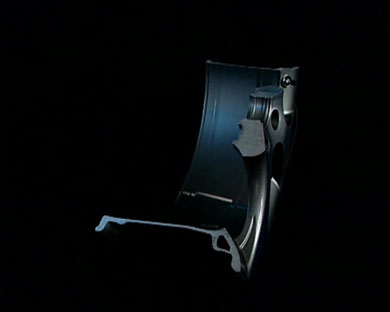 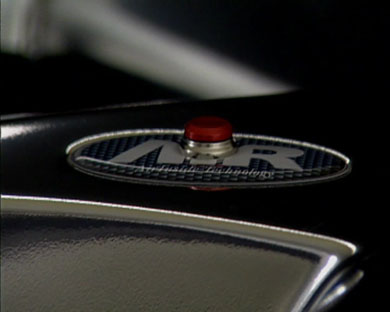 |
The primary focus of BBS Germany for the seminar was the launch of its new 'Air-Inside' wheels for Malaysia. As its name implies, the highlight of this technologhy is BBS's new patented "AIR INSIDE TECHNOLOGY". The underlying idea for AIR-INSIDE TECHNOLOGY is the utilization of hollow chambers instead of solid alloy in the construction of the wheels. Again, from high-school physics, we have learned that a hollow tube can be made almost as strong as a solid one but offers additional benefits of weight savings. BBS' Air-Inside wheels features circumferential hollow chambers and hollow spokes. They allow BBS to produce wheels that are almost as strong but with noticeably lower weight than one which is solid. BBS says that such wheels also offer considerably better stability. As a direct result, both the driving dynamics and the driving comfort are improved.
In the production of the Air-Inside wheels, the wheels are first casted with a flange in the middle of the rim. The inner and outer shoulders of the rim are then shaped into hollow chambers by flow-forming and then sealed by laser welding. By doing this, BBS can make the shoulders considerably thicker without incurring as much in weight penalty. This actually allows them to make the Air Inside wheels stronger. BBS says the resistance to the deformation of the rim shoulder has been increased by a significant 60% compared to contemporary versions and this of course significantly increases the structural strength of the wheel and therefore its safety. Meanwhile the hollow champers in the spokes increases the air volume of the wheel - the spokes can now be made thicker again without incurring excessive weight penalties thus resulting in greater structural strength. The construction procedure reduced the weight of the AI wheel by approximately 5.3kg per wheel compared to an equivalent one with a completely solid interior. Other advantages cited by BBS includes a counteraction to the disadvantageous reduction of the air volume in low profile tyres, a higher safety pressure when there is a loss of air from the tyres, improved cushioning characteristics, less noise, and finally lower tyre flange temperatures.
| Manfacturing process of BBS' AIR-INSIDE TECHNOLOGY wheels |
|---|
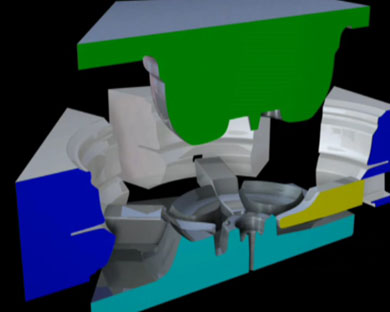 
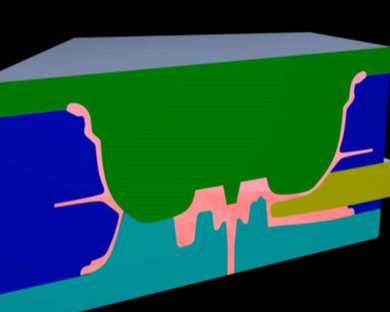 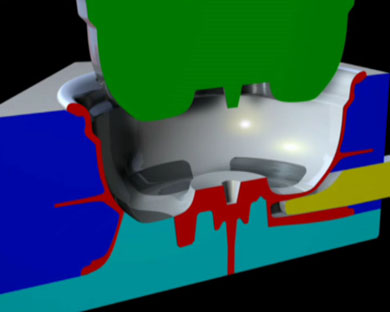 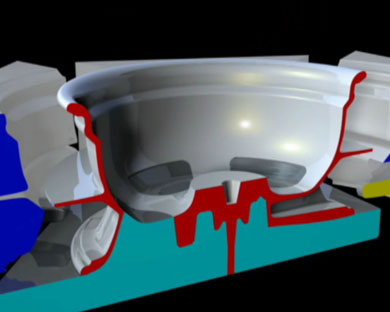
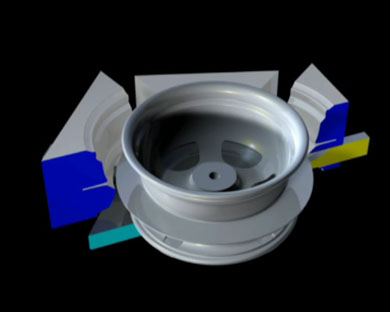 This sequence of screen captures off a BBS promotional movie clip shows the BBS process of casting the unique hollow spokes of their new Air-Inside wheels. BBS also casted an extra flange in the middle of the wheel which is later used to form the chamber for the how rim shoulder. |
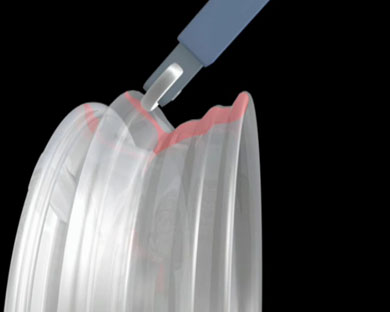 
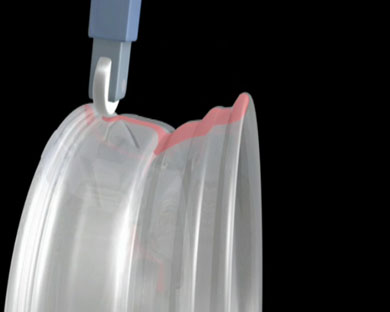 These series of screen captures shows how the flange of the casted wheel is 'rolled over' by a roller bearing to create the hollow shoulder. The joining edge is then sealed by laser. The same process is used to flatten out the inner wheel perimeter. |
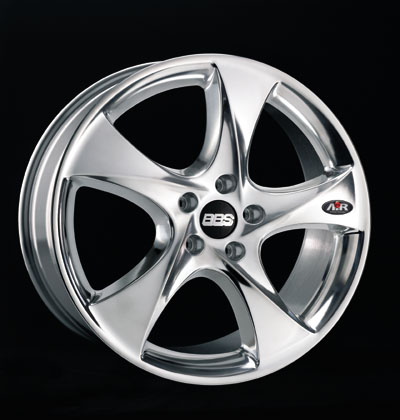 BBS introduced two models of their wheels which uses this 'Air Inside' technology. The
first is the AIR 1 AI. This is a one piece casted wheel using the hollow chambers
and spokes of the Air-Inside technology. According to BBS, exploitation of this technology increases the
stability of the wheel by up to 60 %. The weight is at the same time reduced of nearly 22 kg per wheel
set (i.e. 5.3kg per wheel compared to an equivalent solid casted wheel). The spokes are
hollow cast using hydraulically actuated inserts. The inner and outer flanges are then shaped
into hollow areas through flow-forming and laser welding. Finally the surface is ball polished.
The new AIR I AI wheel is also equipped with an integrated valve, being positioned in the middle
of a spoke. The result is that the valve is not only more accessible but it is also better
protected against pollution, especially in off road use. The BBS AIR I AI wheel comes in sizes
of 10.0" x 20" and 10.5" x 22".
BBS introduced two models of their wheels which uses this 'Air Inside' technology. The
first is the AIR 1 AI. This is a one piece casted wheel using the hollow chambers
and spokes of the Air-Inside technology. According to BBS, exploitation of this technology increases the
stability of the wheel by up to 60 %. The weight is at the same time reduced of nearly 22 kg per wheel
set (i.e. 5.3kg per wheel compared to an equivalent solid casted wheel). The spokes are
hollow cast using hydraulically actuated inserts. The inner and outer flanges are then shaped
into hollow areas through flow-forming and laser welding. Finally the surface is ball polished.
The new AIR I AI wheel is also equipped with an integrated valve, being positioned in the middle
of a spoke. The result is that the valve is not only more accessible but it is also better
protected against pollution, especially in off road use. The BBS AIR I AI wheel comes in sizes
of 10.0" x 20" and 10.5" x 22".
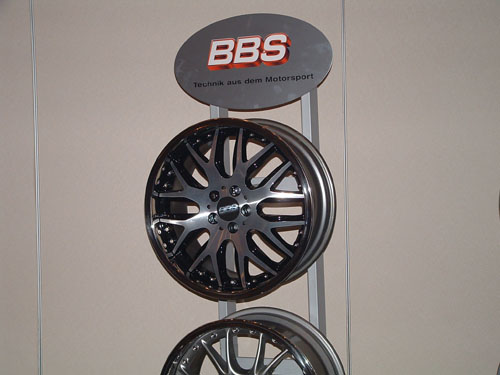
The other model is the BBS AIR II CK. This two-piece wheel features a center connected to the rim by titanium bolts. The BBS AIR INSIDE TECHNOLOGY used on this wheel increases the resistance to the deformation of the inner shoulder by up to 60 % while the hollow cast rim shoulder results in better acceleration and braking characteristics. The AIR II CK also features a polished stainless steel rim protector. This protector also has an additional asthetic appeal of covering unsightly balancing weights on the outer flange. The special design of rim protector makes it easily replaceable if it is damaged, without taking off the tyre. The center of the wheel is a new BBS "titanium-silver" painted design and of course the two individual pieces are assembled together with super-strong and lightweight titanium bolts. Although introduced in Malaysia only this year, this model has been available since spring 2006 in the sizes 8,0 x 18" to 10,0 x 19".
BBS-Japan
Next it was the turn of another BBS company to present in the seminar. This was what I tend to call 'BBS-Japan'. As they got on the stage, I was surprised to learn that BBS Japan is in fact, not a subsidiary of BBS Kraftfahrzeugtechnik AG (or BBS Germany as I called them earlier). Rather it is more of a joint-venture between BBS Germany and Japan's 'ONO Group'. Within the ONO group, the 2 companies of interest to us are BBS-Japan and Washi Beam. Their relationship to BBS Germany, whose brand name they carry is through a technical tie-up partnership. Therefore, BBS Japan do not belong to the BBS International group of Germany but is rather a japanese company in its own right. Washi Beam, established in 1971, have been manufacturing forged wheels in Japan for over 20 years. Within the ONO Group, Washi Beam is the manufacturer for BBS wheels in Japan (for BBS Japan). The main differentiating factor for BBS Japan's alloy wheels is that they are forged wheels. Each BBS wheel is forged from a solid aluminium cylinder, through a 3-stage forging process. For those who are unfamiliar, the process of forging is by heating up the solid piece of aluminium and then using an extremely powerful hydraulic press (5,000 tons !) to reform the semi-molten aluminium into the desired shape. The Washi beam manufacturing process does this over 3 consecutive stages, each reforming the initial piece of solid cylindrical aluminium into the final wheel. Other manufacturers employs only a 1 stage forging process. The diagram below, supplied by Washi Beam illustrates this uniqueness. Also important to note is that Washi Beam uses aluminium of higher grade than other manufacturers.
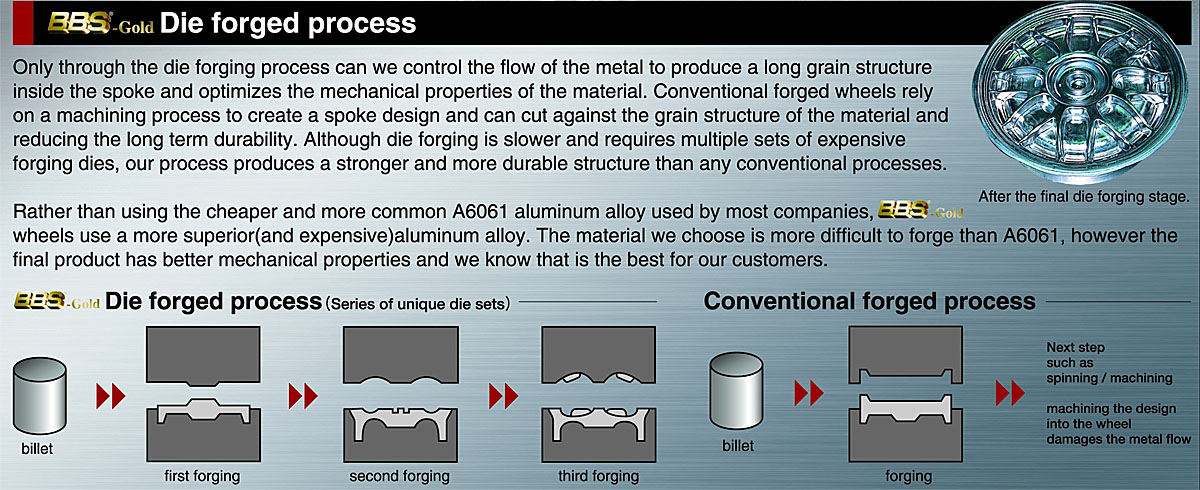
 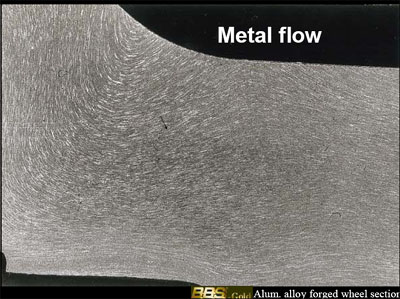 |
Besides making BBS forged wheels, Washi Beam is also supplying via an OEM arrangement, wheels to all automobile manufacturers in Japan as well as across the world. Cars includes Ford GT, Mitsu EVO IV MR, R33, etc.
BBS Japan and Washi Beam are especially proud of their association with the Subaru World Rally Team (SWRT) who races Subaru Imprezzas in the World Rally Championship. BBS Japan's BBS-Gold aluminium alloy wheels are produced using the same aluminium alloy material as well as production line and processes as that for the SWRT WRC Racing wheels used in the Subaru WRC race cars. So their message to customers is that the BBS-Gold aluminium alloy wheels they buy are truly 'rally proven' because the same wheels are used on the actual rally car.
Eibach
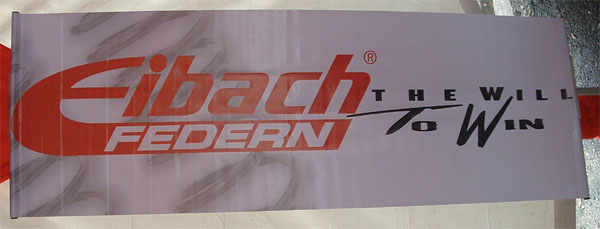 Eibach is a well known name to many Honda performance enthusiasts. Eibach's Pro-Kit are probably
one of the best known aftermarket springs for performance enthusiasts. My first modification to
my DA6 was a set of Eibach Pro-Kits.
Eibach is a well known name to many Honda performance enthusiasts. Eibach's Pro-Kit are probably
one of the best known aftermarket springs for performance enthusiasts. My first modification to
my DA6 was a set of Eibach Pro-Kits.
Founded in 1951 in Ronkhausen by Heinrich Eibach, Eibach is now present in many countries across the world including USA, Japan and even South East Asia. All companies are now held under Eibach AG which is the holding company.
Eibach is a leading manufacturer for Performance Suspension Springs, components and systems and Hi-tech industrial springs meant for critical applications. Eibach dedicates itself to building the finest suspension components in the world. Their motto is 'The Will to Win' and this manifests itself in their involvement in all forms of top-level motorsports, including Formula-1 (all F1 team uses Eibach springs)
While well known for their famous suspension springs – Eibach Pro-Kit and Sport-Line, Eibach has also branched out into other closely related Suspension performance products. Eibach now see themselves as Eibach Springs – the Suspension Company. The Eibach Performance Product range comprises
- “Pro-Kit” Performance Suspension Springs
- “Sportline” Sport Suspension Springs
- “Pro-Damper” Performance Shock Absorbers
- “Anti-Roll-Kit” Performance Stabilizer Bars
- “Pro-System” Performance Suspension Systems
- “Pro-Spacer” Aluminium Wheel Spacers
- “Pro-Alignment” Wheel Alignment Kits
- “EMS” Eibach Motorcycle Springs
- “EVS” Eibach Valve Springs
- “ERS” Eibach Race Springs (Suspension)
Eibach also has a limited range of shock absorbers and what they call "Preassembled Spring-Damper-Cornermodul" (more commonly known as a coil-over). Eibach does not mass produce shock absorbers, but they do offer a service for developing and supplying them, in partnership with world-respected shock-absorber manufacturers, to the exact specifications necessary for optimum system performance.
The development and engineering process is a partnership between the customer (the people asking for the shock), the shock absorber manufacturer and Eibach Engineering. Eibach does the final assembly of the suspension system components. In addition they are also equipped and willing to do small production runs of special series shock absorbers.
Finally, Eibach also does a very diverse range of industrial springs, covering almost all areas where high-quality and individual solutions are required.
| A Range Of Eibach Products on Display at the Seminar | |
|---|---|
 | 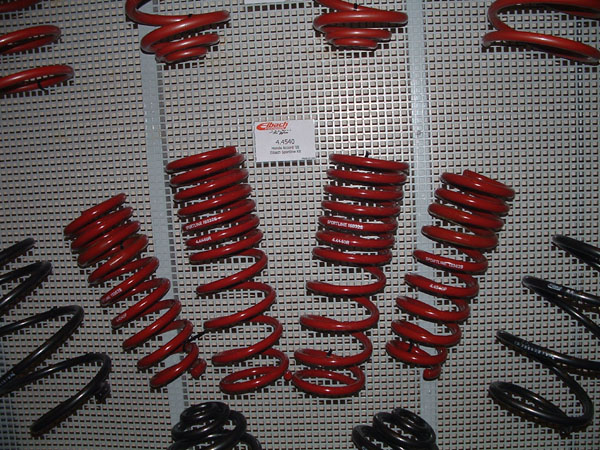 |
| Pro-Kit | Sport-Line |
 | 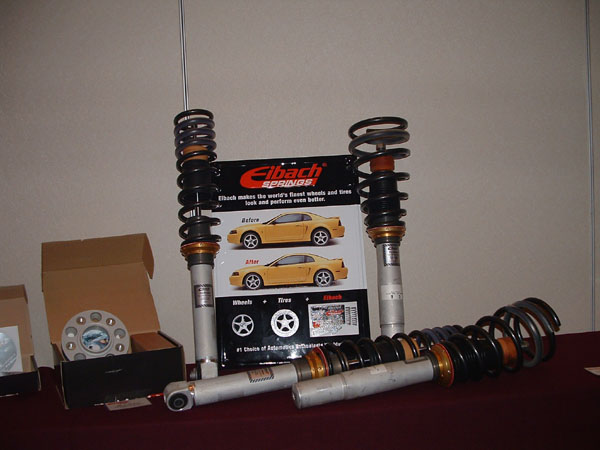 |
| Pro-Damper shocks | Pro-System Coil-Overs |
 | 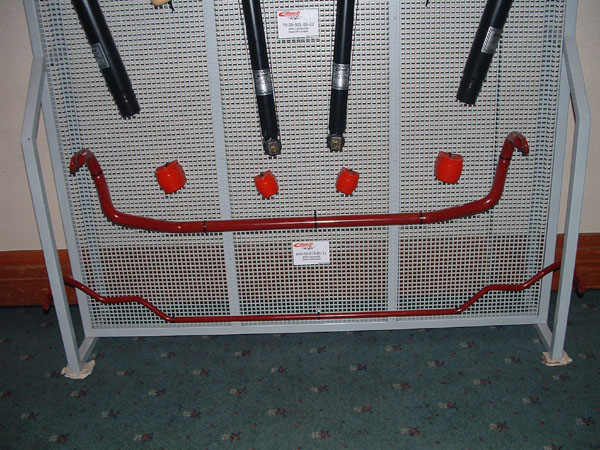 |
| Pro-Spacers - to adjust wheel offset | Anti-Roll Bar with polyurethane mounts |
Conclusion
This concludes part 1 of the coverage of the seminar. The seminar continued on to the afternoon and endsed with a test-drive of 3 cars supplied by local car manufacturer NAZA. This will be covered in a follow-up part-2 article.
Wong KN
April 2007
© Temple of VTEC Asia